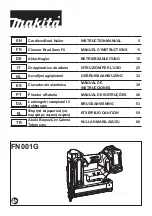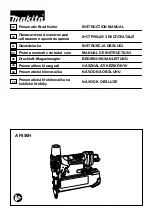
INSTRUCTION MANU
AL
31˚
CLIPPED HEAD FR
AMING NAILER
MODEL: D51822-
XE
20˚ FULL ROUND HEAD FR
AMING NAILER
MODEL: D51844-
XE
D
E
WALT Industrial Tool Co.,
701 East Joppa Road, Baltimore, MD 21286 • 20 Fletcher Road, Mooroolbark, VIC 3138 Australia
(APR04) Form No. 623992-00 D51822-XE, D51744-XE Copyright © 2004
The following are trademarks for one or more D
E
WALT power tools: the yellow and black color scheme; the “D” shaped
air intake grill; the array of pyramids on the handgrip; the kit box configuration; and the array of lozenge-shaped humps
on the surface of the tool.
SAVE THESE INSTRUCTIONS
Important Safety Instructions for Pneumatic Tools
WARNING:
When using any pneumatic tool, all safety precautions, as outlined below, should be followed
to avoid the risk of death or serious injury. Read and understand all instructions before operating the tool.
•
Use the tool only for its intended use. Do not discharge fasteners into open air, concrete,
stone, extremely hard woods, knots or any material too hard for the fastener to penetrate.
Do not use the body of the tool or top cap as a hammer.
Discharged fasteners may follow
unexpected path and cause injury. (Fig. L)
•
Always keep fingers clear of contact trip to prevent injury from inadvertent release of
nails.
(Fig. M)
• Refer to the Maintenance and Repairs sections for detailed information on the proper
maintenance of the tool
•
Always operate the tool in a clean, lighted area.
Be sure the work surface is clear of any
debris and be careful not to lose footing when working in elevated environments such as
rooftops.
•
Do not drive fasteners near edge of material.
The workpiece may split causing the fastener
to ricochet, injuring you or a co-worker. Be aware that the nail may follow the grain of the
wood (shiner), causing it to protrude unexpectedly from the side of the work material. Drive
the nail perpendicular to the grain to reduce risk of injury. (Fig. N)
•
Keep hands and body parts clear of immediate work area.
Hold workpiece with clamps
when necessary to keep hands and body out of potential harm. Be sure the workpiece is
properly secured before pressing the nailer against the material. The contact trip may cause
the work material to shift unexpectedly. (Fig. O)
•
Do not use tool in the presence of flammable dust, gases or fumes.
The tool may produce
a spark that could ignite gases causing a fire. Driving a nail into another nail may also cause
a spark. (Fig. P)
•
Keep face and body parts away from back of the tool cap when working in restricted
areas.
Sudden recoil can result in impact to the body, especially when nailing into hard or
dense material. (Fig. Q)
BUMP ACTION TRIGGER
•
When using the bump action trigger, be careful of unintentional double fires resulting
from tool recoil.
Unwanted fasteners may be driven if the contact trip is allowed to acci-
dentally re-contact the work surface. (Fig. R)
TO AVOID DOUBLE FIRES:
• Do not engage the tool against the work surface with a strong force.
• Allow the tool to recoil fully after each actuation.
• Use sequential action trigger.
•
When “bump” actuating the framing nailer, always keep tool in control.
Inaccurate
placement of tool can result in misdirected discharge of a fastener.
SEQUENTIAL ACTION TRIGGER
• When using the sequential action trigger, do not actuate the tool unless the tool is
placed firmly against the workpiece.
•
Do not drive nails onto the heads of other fasteners.
Strong recoil, jammed fasteners, or ric-
ocheted nails may result.
•
Be aware of material thickness when using the framing nailer.
A protruding nail may
cause injury.
•
Be aware that when the tool is being utilized at pressures on the high end of its operating
range, nails can be driven completely through thin or very soft work material.
Make sure
the pressure in the compressor is set so that nails are set into the material and not pushed
completely through. (Fig. S)
•
Do not drive nails blindly into walls, floors or other work areas.
Fasteners driven into live
electrical wires, plumbing, or other types of obstructions can result in injury. (Fig. T)
• Stay alert, watch what you are doing and use common sense when operating a power
tool. Do not use tool while tired or under the influence of drugs, alcohol, or medication.
A
moment of inattention while operating power tools may result in serious personal injury.
•
Always assume the pneumatic nailer contains fasteners and handle it accordingly.
•
Always check the pneumatic nailer is in good order prior to use
. Do not use the Pneumatic
Nailer if the trigger and the safety mechanism are not working correctly.
•
Do not load the pneumatic pailer with fasteners when any part of the operating mecha-
nism (trigger or nose piece) is depressed.
•
Always take care when skew nailing or when working close to the edge of any material.
WARNING:
Use of this product will expose you to chemicals known to the State of California
to cause cancer, birth defects and other reproductive harm.
Avoid inhaling vapors and dust, and
wash hands after using.
BEFORE OPERATING THIS TOOL, CAREFULLY READ AND UNDERSTAND ALL INSTRUCTIONS IN
THE “IMPORTANT SAFETY INSTRUCTIONS” SECTION.
FIG. A
FIG. B
FIG. C
FIG. D
FIG. E
FIG. F
FIG. G
FIG. H
FIG. I
FIG. J
•
Actuating tool may result in flying debris, collation material, or dust which could harm
operator’s eyes.
The operator and all those persons in the general area should wear safety
glasses with permanently attached side shields. Approved safety glasses are imprinted with the
characters “Z87.1”. It is the employer’s responsibility to enforce the use of eye protection
equipment by the tool operator and other people in the work area. (Fig. A)
•
Always wear appropriate personal hearing and other protection during use.
Under some
conditions and duration of use, noise from this product may contribute to hearing loss. (Fig. A)
•
Use only clean, dry, regulated air.
Condensation from an air compressor can rust and dam-
age the internal workings of the tool. (Fig. B)
•
Regulate air pressure. Use air pressure compatible with ratings on the nameplate of the
tool.
(Not to exceed 120 psi, 8.3 bar) Do not connect the tool to a compressor rated at over
175 psi. The tool operating pressure must never exceed 175 PSI even in the event
of regulator failure. (Fig. C)
•
Use air hoses rated for safe operation of the tool.
Hoses rated for a maximum operating
pressure of 150 PSI or 150% of the maximum system pressure, whichever is greater, must
be utilized. (Fig. D)
•
Do not use bottled gases to power this tool.
Bottled compressed gases such as oxygen,
carbon dioxide, nitrogen, hydrogen, propane, acetylene or air are not for use with pneumatic
tools. Danger of explosion and/or serious personal injury may result. (Fig. E)
•
Use couplings that relieve all pressure from the tool when it is disconnected from the
power supply.
Use hose connectors that shut off air supply from compressor when the tool is
disconnected. (Fig. F)
•
Disconnect tool from air supply when not in use. Always disconnect tool from air supply
and remove fasteners from magazine before leaving the area or passing the tool to another
operator. Do not carry tool to another work area with air supply connected. Do not make
adjustments, remove magazine, perform maintenance or clear jammed fasteners while
connected to the air supply.
If the contact trip is adjusted when the tool is connected to the air
supply and nails are loaded, accidental discharge may occur. (Fig. G)
• Do not remove, tamper with, or otherwise cause the tool, trigger, or contact trip to
become inoperable.
Do not tape or tie trigger or contact trip in the ON position. Do not
remove spring from contact trip. Uncontrolled discharge could result.
• Do not operate a tool if any portion of the tool, trigger, or contact trip is inoperable, discon-
nected, altered, or not working properly.
Leaking air, damaged parts or missing parts should
be repaired or replaced before use. (Fig. H)
•
Do not alter or modify the tool in any way.
(Fig. I)
• Always assume that the tool contains fasteners.
•
Do not point the tool at co-workers or yourself at any time.
No horseplay! Work safe!
Respect the tool as a working implement. (Fig. J)
• Keep bystanders, children, and visitors away while operating a power tool.
Distractions
can cause you to lose control.
•
Do not carry the tool from place to place holding the trigger.
Accidental discharge could
result.
•
Always use trigger lock-off when tool is not in immediate use.
Using the trigger lock-off
will prevent accidental discharge.
•
Do not overreach.
Maintain proper footing and balance at all times. (Fig. K)
•
Make sure hose is free of obstructions or snags.
Entangled or snarled hoses can cause
loss of balance or footing.
FIG. K
FIG. N
FIG. L
FIG. M
FIG. Q
FIG. R
FIG. S
FIG. T
EXTERNAL TOOL PARTS
PUSHER
MAGAZINE
TRIGGER
CONTACT
TRIP
DEPTH
SETTING
EXHAUST
D51822 Clipped Head
D51844 Full Round Head
Height
12-3/4'' (32.4 cm)
12-3/4'' (32.4 cm)
Width
5'' (12.7 cm)
5'' (12.7 cm)
Length
18 5/8'' (47.3 cm)
20 3/4'' (52.7 cm)
Weight
7.3 lb (3.40 kg)
7.4 lb (3.44 kg)
Magazine Angle
31˚
20˚
Recommended
70 - 120 psig
70 - 120 psig
Operating Pressure
(4.9 to 8.3 bar,
(4.9 to 8.3 bar,
5 to 8.5 kg/cm
2
)
5 to 8.5 kg/cm
2
)
Air consumption per
7.2 cfm @ 100 psi
7.2 cfm @ 100 psi
100 cycles
203.9 l/m @ 6.9 bar
203.9 l/m @ 6.9 bar
Air consumption per
.072 cfm @ 100 psi
.072 cfm @ 100 psi
single shoot
2.039 l/m @ 6.9 bar
2.039 l/m @ 6.9 bar
Loading capacity
Up to 80 Nails
Up to 65 Nails
TOOL SPECIFICATIONS
D51822 Clipped Head
D51844 Full Round Head
Nail Lengths
2'' - 3-1/2'' (50 mm - 90 mm)
2'' - 3-1/2'' (50 mm - 90 mm)
Shank Diameters
.113'' - .131'' (2.9 mm - 3.3 mm)
.113'' - .148'' (2.9 mm - 3.8 mm)
Nail Stick Angles
31˚ - 34˚
20˚ - 22˚
Shank Types
Smooth, Ring, Screw
Smooth, Ring, Screw
NAIL SPECIFICATIONS
FIG. P
FIG. O





















